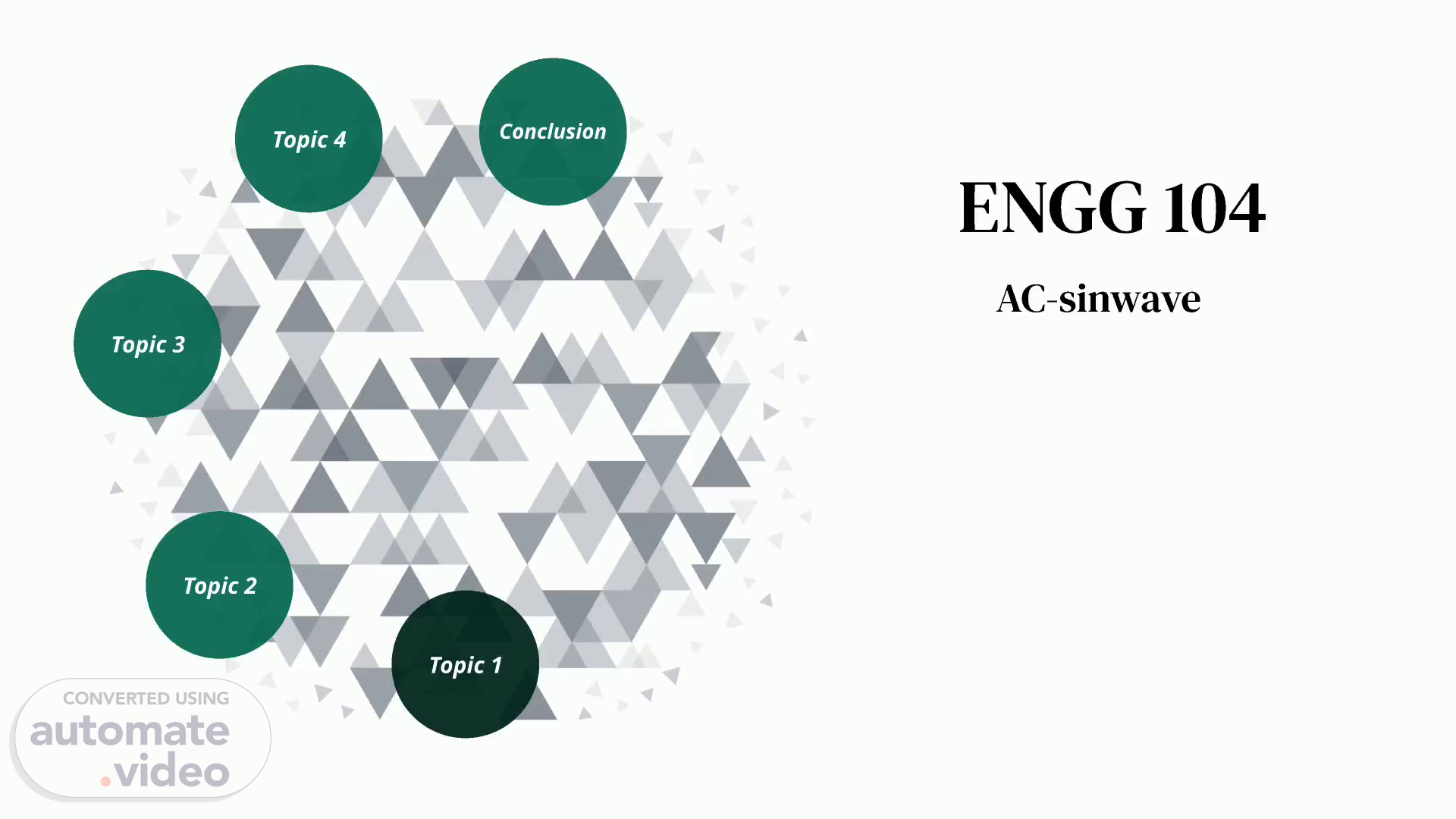Scene 1 (0s)
Topic 4 Conclusion Topic 3 v Arks' Topic 2 Topic 1 ENGG 104 AC-sinwave.
Scene 2 (7s)
What is AC-sinewave ? It is the sinusoidal waveform also known as sine wave which is the fundamental AC(alternating current and alternating volatge waveform. Usually electrical sine wave are named from the mathematical function with the same shap as such sine waves are characterized by the amplitude and period (the sine wave) Tme Image of AC-sinewave 4.
Scene 3 (23s)
Topic 4 Conclusion Topic 3 v Arks' Topic 2 Topic 1 ENGG 104 AC-sinwave.
Scene 4 (30s)
What is AC ? What is AC and its characteristics ? AC Characteristics ?.
Scene 5 (37s)
What is AC? • AC stands for Alternating current . • AC is a electric current that constantly changes direction which is unlike DC (direct current) that flows in particular direction. • Most electrical appliances used in homes are AC • AC is also the standard for electrical distribution.
Scene 6 (51s)
What is AC ? What is AC and its characteristics ? AC Characteristics ?.
Scene 7 (59s)
Characteristics ofAC • It will constantly change its direction. • It presents periodic and repitative waveform. • It's frequency(Hertz) and amplitude(volatge) can vary. • AC waveform is the most common sinewave..
Scene 9 (1m 16s)
Topic 4 Conclusion Topic 3 v Arks' Topic 2 Topic 1 ENGG 104 AC-sinwave.
Scene 11 (1m 29s)
Waveform Representation Sine Wave • Graphical reresentation of a signal in the form of sinewave • Through the image given we can observe the peak volatge(Vp),frequency and period of the wave form. • The peak voltage(Vp) is the higest volatge value compared to the zero volts. • The frequency (f)can be observed based on how many times one cycle of the waveform is repreated per second. Which is measured in Hertz(Hz) and determins the speed of the waveform repetition. • The period(T) is known as the repeating pattern with constant wavel and frequency.Which is reciprocal of frequency(T = I/f)..
Scene 12 (1m 54s)
Sinewave basics • A sinewave represents a single frequency with no harmonics and is also considered as an acoustically pure tone. • The sinewave is characterised by it's amplitude(peak voltage),frequency(cycles per second), and phase. • It's often written as : V(t) = V_max*sin(2T1ft + CD) where V(t) is the voltage,V_max is the peak voltage,f is the frequency, and cD is the phase. Waveform Representation Amplitude and Phase.
Scene 13 (2m 12s)
Amplitude (V) The vertical distance between the sinusoidal axis and the maximum value of the function is known as amiplitude. Phase(+) It indicates where the wave is in its cycle.Which is measured in degrees(00-3600) or radians(0-2T1).
Scene 14 (2m 25s)
Sinewave basics • A sinewave represents a single frequency with no harmonics and is also considered as an acoustically pure tone. • The sinewave is characterised by it's amplitude(peak voltage),frequency(cycles per second), and phase. • It's often written as : V(t) = V_max*sin(2T1ft + CD) where V(t) is the voltage,V_max is the peak voltage,f is the frequency, and cD is the phase. Waveform Representation Amplitude and Phase.
Scene 15 (2m 43s)
Topic 4 Conclusion Topic 3 v Arks' Topic 2 Topic 1 ENGG 104 AC-sinwave.
Scene 16 (2m 50s)
Practical Application and Importance of Sinewave • Its the foundation of electrical power generation,distribution, and usage. • Rely on the changing direction of current for operation. • It is efficient for long-distance power transmission. • The smooth waveform minimize interference and distortion..
Scene 17 (3m 4s)
Topic 4 Conclusion Topic 3 v Arks' Topic 2 Topic 1 ENGG 104 AC-sinwave.
Scene 18 (3m 11s)
Conclusion As we all know AC sinewave are fundamental concept in engineering,mainly electrical engineering and sinewave are known to be the standard for electrical distribution and power consuption. Also understanding sinewaves is very important when it comes to working wth electrical system and devices. 4.
Scene 19 (3m 26s)
Topic 4 Conclusion Topic 3 v Arks' Topic 2 Topic 1 ENGG 104 AC-sinwave.
